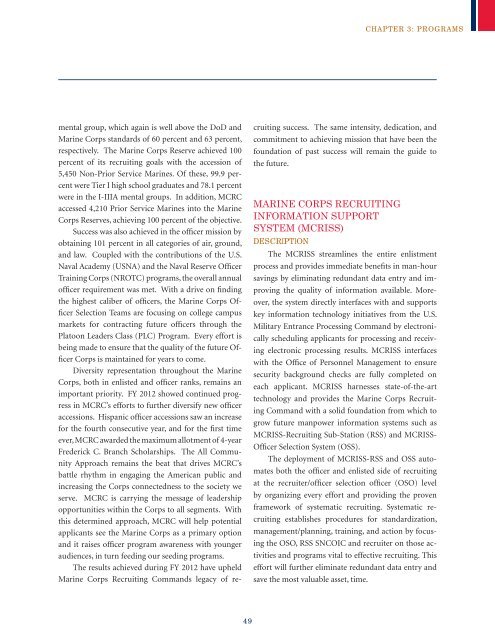USMC Concepts & Programs 2013 - Defense Innovation Marketplace
USMC Concepts & Programs 2013 - Defense Innovation Marketplace
USMC Concepts & Programs 2013 - Defense Innovation Marketplace
Create successful ePaper yourself
Turn your PDF publications into a flip-book with our unique Google optimized e-Paper software.
chapter 3: programs<br />
mental group, which again is well above the DoD and<br />
Marine Corps standards of 60 percent and 63 percent,<br />
respectively. The Marine Corps Reserve achieved 100<br />
percent of its recruiting goals with the accession of<br />
5,450 Non-Prior Service Marines. Of these, 99.9 percent<br />
were Tier I high school graduates and 78.1 percent<br />
were in the I-IIIA mental groups. In addition, MCRC<br />
accessed 4,210 Prior Service Marines into the Marine<br />
Corps Reserves, achieving 100 percent of the objective.<br />
Success was also achieved in the officer mission by<br />
obtaining 101 percent in all categories of air, ground,<br />
and law. Coupled with the contributions of the U.S.<br />
Naval Academy (USNA) and the Naval Reserve Officer<br />
Training Corps (NROTC) programs, the overall annual<br />
officer requirement was met. With a drive on finding<br />
the highest caliber of officers, the Marine Corps Officer<br />
Selection Teams are focusing on college campus<br />
markets for contracting future officers through the<br />
Platoon Leaders Class (PLC) Program. Every effort is<br />
being made to ensure that the quality of the future Officer<br />
Corps is maintained for years to come.<br />
Diversity representation throughout the Marine<br />
Corps, both in enlisted and officer ranks, remains an<br />
important priority. FY 2012 showed continued progress<br />
in MCRC’s efforts to further diversify new officer<br />
accessions. Hispanic officer accessions saw an increase<br />
for the fourth consecutive year, and for the first time<br />
ever, MCRC awarded the maximum allotment of 4-year<br />
Frederick C. Branch Scholarships. The All Community<br />
Approach remains the beat that drives MCRC’s<br />
battle rhythm in engaging the American public and<br />
increasing the Corps connectedness to the society we<br />
serve. MCRC is carrying the message of leadership<br />
opportunities within the Corps to all segments. With<br />
this determined approach, MCRC will help potential<br />
applicants see the Marine Corps as a primary option<br />
and it raises officer program awareness with younger<br />
audiences, in turn feeding our seeding programs.<br />
The results achieved during FY 2012 have upheld<br />
Marine Corps Recruiting Commands legacy of recruiting<br />
success. The same intensity, dedication, and<br />
commitment to achieving mission that have been the<br />
foundation of past success will remain the guide to<br />
the future.<br />
MARINE CORPS RECRUITING<br />
INFORMATION SUPPORT<br />
SYSTEM (MCRISS)<br />
Description<br />
The MCRISS streamlines the entire enlistment<br />
process and provides immediate benefits in man-hour<br />
savings by eliminating redundant data entry and improving<br />
the quality of information available. Moreover,<br />
the system directly interfaces with and supports<br />
key information technology initiatives from the U.S.<br />
Military Entrance Processing Command by electronically<br />
scheduling applicants for processing and receiving<br />
electronic processing results. MCRISS interfaces<br />
with the Office of Personnel Management to ensure<br />
security background checks are fully completed on<br />
each applicant. MCRISS harnesses state-of-the-art<br />
technology and provides the Marine Corps Recruiting<br />
Command with a solid foundation from which to<br />
grow future manpower information systems such as<br />
MCRISS-Recruiting Sub-Station (RSS) and MCRISS-<br />
Officer Selection System (OSS).<br />
The deployment of MCRISS-RSS and OSS automates<br />
both the officer and enlisted side of recruiting<br />
at the recruiter/officer selection officer (OSO) level<br />
by organizing every effort and providing the proven<br />
framework of systematic recruiting. Systematic recruiting<br />
establishes procedures for standardization,<br />
management/planning, training, and action by focusing<br />
the OSO, RSS SNCOIC and recruiter on those activities<br />
and programs vital to effective recruiting. This<br />
effort will further eliminate redundant data entry and<br />
save the most valuable asset, time.<br />
49

















